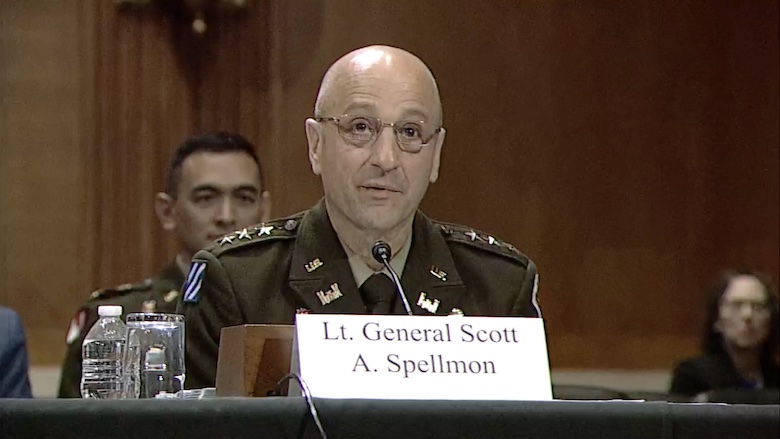Corps Lays Out Multi-Pronged Plan to Cope With Rising Project Costs
View Source
Lt. General Scott Spellmon, US Army Chief of Engineers, told the Senate Environmental and Public Works Committee on May 3 that the agency's $92 billion construction program is "the largest we've ever seen."
Screenshot from video courtesy Senate EPW Committee
The U.S. Army Corps of Engineers, far from immune from the impact of worker shortages and increased materials costs on its projects, is taking a variety of steps to grapple with the problems and keep work on the path to completion.
With influxes of funds from the 2021 Infrastructure Investment and Jobs Act and regular appropriation measures, the agency's already-heavy workload has grown.
Testifying at a Senate Environment and Public Works Committee hearing on May 3, Lt. Gen. Scott Spellmon, U.S. Army Chief of Engineers, noted that the Corps program, which includes civil works, military construction and other activities and now totals $92 billion, is "the largest we’ve ever seen.”
[View a video of the hearing here.]
Michael Connor, assistant Army secretary for civil works, told the committee that about a decade ago, the Corps had about 37,000 employees and a total program of $37 billion. Despite the mission growth, its workforce has only grown to about 38,000. "It's quite the challenge," Connor said.
Committee Chair Tom Carper (D-Del.) asked Spellmon about reports of cost overruns on Corps civil works infrastructure projects. The Corps chief acknowledged that the agency is working on multiple fronts to tackle cost pressures, which are widespread throughout the construction industry.
Jordan Howard, Associated General Contractors of America counsel for federal construction and regulatory affairs, says its member companies working with all federal construction agencies are experiencing higher costs on projects.
Speaking of federal construction agency work generally, Howard said via email, "Unfortunately, there has been little to no relief, apart from extended time durations, provided to federal construction contractors to cope with the negative consequences from both the COVID-19 pandemic and the supply chain disruptions that still affect the federal construction industry."
Strategies for Labor, Materials
Spellmon said that the main challenge facing the Corps and its contractors is a shortage of skilled craft workers. “That’s the number-one cost driver that we’re seeing on our projects,” he said, with increased prices for construction materials “a close second.”
On the personnel side, thanks to a provision in the infrastructure law, the Corps has funds to hire more cost engineers. That will allow it to provide better cost estimates to Connor's office. Spellmon said last year the Corps had about 350 cost engineers, and has since added 72, aiming for a total of 500.
In addition, Connor said that the Corps is looking at discussing "re-scoping" some projects with projects' nonfederal sponsors
Spellmon said materials price trends vary from state to state among types of products, adding that the Corps is seeing some improvements.
“Timber is coming down, steel is leveling off,” Spellmon said. "But we’re still seeing 40-year highs on glass products and asphalt products."
Spellmon also said that when the Corps foresees long lead times in acquiring certain materials and equipment, such as switchgears or HVAC systems, it is turning to alternate suppliers.
The agency also is working with the Defense Logistics Agency to speed the flow of supplies, which Spellmon said has cut delivery times by as much as half. “We want to finish everything that we start and we remain committed to that,” he said.
Connor also said the Corps is looking at the possibility of shifting funds not yet allocated to particular projects to advance active ones. Shifting funds between projects can be a sensitive matter for federal and local officials who represent areas where those projects are located.
Connor told the committee that a funding transfer "doesn't work unless I'm transparent with all of you and any of the interests involved."
Sen. Shelley Moore Capito (W.Va.), the committee's top Republican, discussed the local impacts of funding shifts and said that "transparency is the key here."
Help from WRDA Section 8155
Another tool the Corps is using to keep projects moving is Section 8155 of the 2022 Water Resources Development Act.
According to comments from Connor's office to ENR, that section of the statute provides a "pathway" to keep authorized projects going that have not yet started construction or are under construction and have experienced cost increases that pushes their total price tags above the amount Congress authorized.
Traditionally, the statement said, if a project's costs rose above the level Congress authorized, the Corps has had to halt or not initiate construction until it sends a "post-authorization" change report to Capitol Hill and federal lawmakers authorize a new total amount.
The Corps can use the provision "subject to the availability of funding," Connor's office noted.
Another wrinkle to Section 8155 is its Dec. 31, 2024, expiration.
AGC's Howard said, that it's "too early to tell" whether the Corps' menu of actions is helping address high costs and allow projects to proceed.
"But we remain optimistic that any increased flexibility the Corps has will translate into positive impacts," he said. "If the Corps has to go back to Congress to request additional funds on a project that has already begun, it costs everyone involved—including the Corps and contractors—more."

